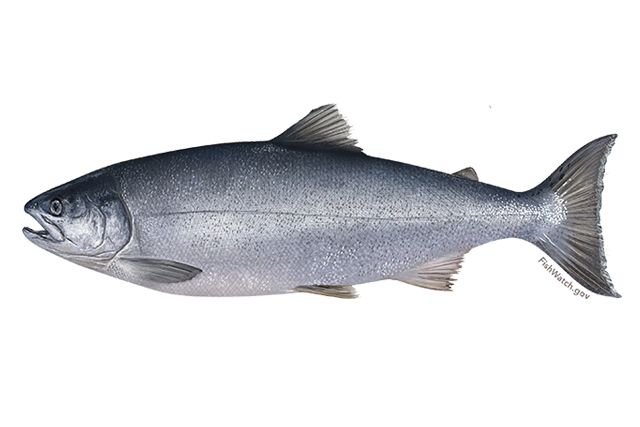Fishery managers say the coming year may be another tough one for anglers in Washington, with low salmon returns expected again in 2020.
The 2020 forecasts for chinook, coho, sockeye, and chum salmon – developed by the Washington Department of Fish and Wildlife and treaty Indian tribes – were released last Friday during a public meeting in Olympia.
The forecast meeting marks the starting point for developing this year’s salmon-fishing seasons in Puget Sound, the Columbia River, and Washington coastal areas, part of the annual “North of Falcon” process that sets salmon fisheries. A series of public meetings is scheduled through early April to develop tentative fishing seasons for the upcoming year.
WDFW Director Kelly Susewind said that fishery managers will be working hard to find the appropriate balance between meeting conservation objectives and providing fishing opportunities, two key tenets of WDFW’s mission.
“Finding that balance is always a challenge,” Susewind said. “But we work with the co-managers to provide opportunities wherever and whenever we can, while meeting conservation goals.”
The forecasts are based on scientific modeling and a variety of data including environmental indicators such as ocean conditions, numbers of juvenile salmon that migrated to marine waters, and numbers of adult salmon that returned in past years.
The following are summaries of this year’s forecasts, which vary by area:
Columbia River: About 233,400 “upriver brights” are expected to return to areas of the Columbia River above Bonneville Dam, a slight increase from the 2019 return of 212,200 fish, but still well below the most recent 10-year average.
An estimated 181,000 Columbia River coho are projected to Washington ocean waters and Columbia River waters, a sharp decrease from the 2019 forecast of about 905,000 fish. Only about a third of that number, 331,500 Columbia River coho actually returned last year.
With the projected weaker coho run and a low chinook run, salmon fisheries will likely be more constrained than last year, according to Kyle Adicks, salmon fisheries policy lead for WDFW.
“We had strong predictions for last year’s coho returns that ultimately didn’t materialize in the way we expected,” Adicks said.
Ocean quotas for coho will be significantly constrained as compared to last year due to these poor projected returns.
This year’s Columbia River mouth forecast of about 51,000 hatchery chinook to the lower Columbia River is up 2,100 fish from last year’s actual return. Those hatchery chinook – known as “tules” – are the backbone of the recreational ocean fishery.
Puget Sound: Roughly 523,500 wild and hatchery coho are expected to return to Puget Sound this year, representing another decline from 2019 when 737,600 were predicted to return. Projected declines for chinook in Puget Sound aren’t quite as drastic, with about 256,800 chinook expected to return to the region, a dip of about 12,000 from last year’s prediction.
In addition, Adicks said that persistent low returns of some stocks – particularly Stillaguamish and mid-Hood Canal chinook – are likely to continue to restrict fisheries.
Information about the salmon season-setting process, including public meeting schedules and materials, are available on WDFW’s website at https://wdfw.wa.gov/fishing/management/north-falcon
WDFW intends to livestream several public meetings, including those scheduled for March 16, March 25, and March 31. The department will provide links to those upcoming livestreams, as well as to the archived video from Friday’s forecast meeting.
Upcoming meetings include:
Ocean options: State, tribal, and federal fishery managers will meet March 3-9 in Rohnert Park, Calif., with the Pacific Fishery Management Council (PFMC) to develop options for the year’s commercial and recreational ocean Chinook and coho salmon fisheries. The PFMC establishes fishing seasons in ocean waters 3 to 200 miles off the Pacific coast.
Regional discussions: Additional public meetings have been scheduled around the state throughout March and into April to discuss regional fishery issues.
Final PFMC: The PFMC is expected to adopt final ocean fishing seasons and harvest levels at its April 3-10 meeting in Vancouver, Wash. The tentative 2020 salmon fisheries package for Washington’s inside waters is scheduled to be completed by the state and tribal co-managers during the PFMC’s April meeting.
In California, fisheries biologists also presented ocean salmon forecasts for 2020.
At the annual Ocean Salmon Informational Meeting held in Santa Rosa, state and federal fishery scientists presented updates on the numbers of California’s spawning salmon, as well as the expected abundance for the upcoming fishing season.
The 2020 ocean abundance projection for Sacramento River fall chinook, a main salmon stock harvested in California waters, is estimated at 473,200 adult salmon, higher than the 2019 forecasts. The Klamath River fall chinook abundance forecast of 186,600 adult salmon is lower than the 2019 forecast and will likely result in reduced fishing opportunity in the areas north of Pt. Arena.
“The outlook for Sacramento River fall Chinook is better than last year, but this season’s fisheries will be tempered by protections needed to conserve low numbers of Klamath River fall chinook,” said Jennifer Simon, an environmental scientist with the California Department of Fish and Wildlife’s Ocean Salmon Project.
Recreational anglers and commercial salmon trollers at the meeting provided comments and voiced concerns to a panel of fishery managers, scientists and industry representatives. Stakeholder input will be taken into consideration when developing three alternatives for this season during the Pacific Fishery Management Council (PFMC) meeting, which will be held March 3-9 in Rohnert Park. Final regulations will be adopted at the April 4-10 PFMC meeting in Vancouver, Washington.
The PFMC may take a conservative approach when crafting 2020 ocean salmon seasons since both SRFC and KRFC stocks are still considered to be overfished under the terms of the federal Salmon Fishery Management Plan.
For more information on the salmon season setting process or general ocean salmon fishing information, visit the Ocean Salmon Project web page or call the ocean salmon hotline at (707) 576-3429.

